Nebula and Cluster of the Month Archive 2022
In this series of articles we draw your attention to Nebulae, Clusters and other Galactic objects that are particularly worthly of an observer's time.
-
NGC 1907 and NGC 1985 in Auriga
December 2022 - Nebula and Cluster of the Month
The bright winter constellations are now dominating the evening sky. By the middle of the month, the bright yellow star Capella, α Aurigae, shines down from a vantage point close to the zenith. Auriga straddles the galactic equator, and so is full of interesting clusters and nebulae. Both this month’s objects are in Auriga.
We’ll start with the open cluster, NGC 1907. It was discovered, predictably, by William Herschel on 17 January 1787, when he described it as
a pretty compressed cluster of small stars, 4’ diameter.
He assigned it to his seventh class (‘pretty much compressed clusters of large or small stars’) as number 39. This description carried on more-or-less unchanged into the NGC, with the addition that the stars range from ninth to twelfth magnitude – something of an overestimate.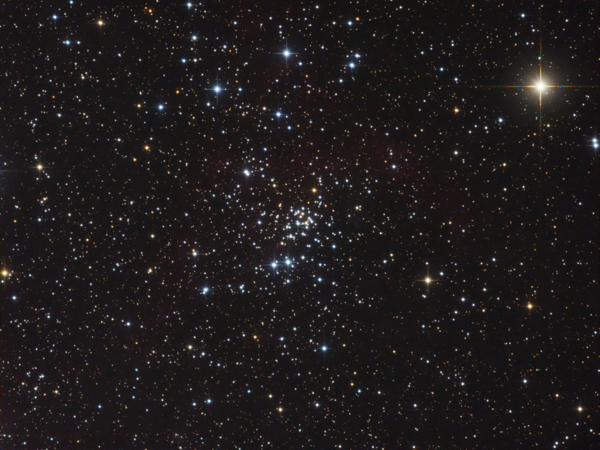
An image of open cluster NGC 1907 provided by Bernhard Hubl. NGC 1907 lies just about 33’ from the centre of the bright open cluster M38 and is often seen sharing an image with that cluster. From M38 move half a degree south and a nudge to the west. It provides an interesting contrast with its brighter and splashier neighbour.
I made my first observation of NGC 1907 with a 4.5” (112mm) reflector way back in 1986. On that night, I noted that the cluster appeared fairly small and was unresolved but heavily mottled. I also noted its clear elongation NW-SE. A very similar observation, made by Patrick Brennan with a 6” (150mm) reflector can be seen in the Webb Society Deep-Sky Observer’s Handbook Volume 3, Open and Globular Clusters.

A sketch of NGC 1907 by Patrick Maloney through a 4.5-inch newtonian telescope in 1986. I’ve revisited the cluster a few times since then, making observations in 2013 and 2018. In 2018 I made my second drawing of the object, reproduced below.
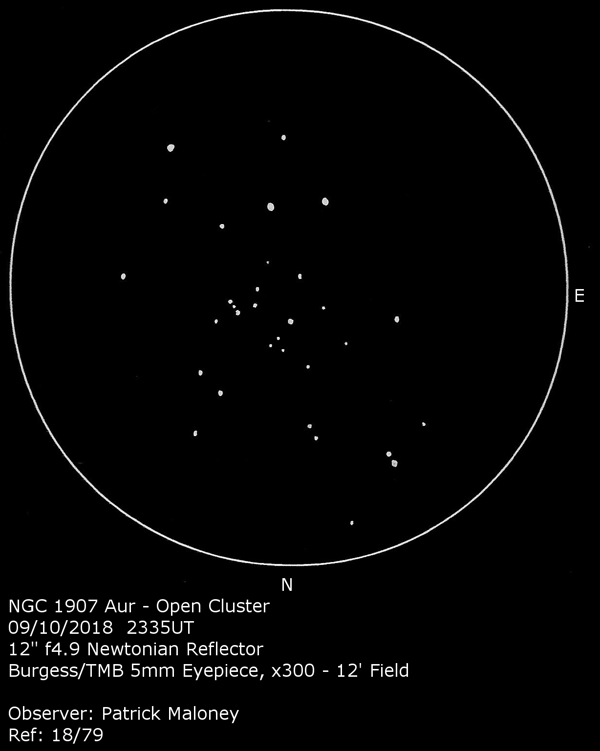
A sketch of NGC 1907 by Patrick Maloney through his 12-inch newtonian telescope at x300 magnification. I plotted over 30 stars on this observation, from magnitude 9 to about 14.5. Most sources list the brightest star as eleventh magnitude, so presumably the brighter stars have been shown to be foreground objects.
Moving slightly less than 4° southeast of NGC 1907 will bring you to our second object for December, a small reflection nebula listed as NGC 1985. It lies about a third of the way along the line from β Tauri and θ Aurigae. Another Herschel discovery, he first saw it on 13 November 1790 and described it as
very faint, very small, round, brighter in the middle.
He placed it in his third class (‘very faint nebulae’) as number 865.
An image of reflection nebula NGC 1985 provided by Pan-STARRS1 Surveys. NGC 1985 is a reflection nebula but has in the past been incorrectly identified as a planetary nebula, having been included in the Perek-Kohoutek catalogue as PK 176+0.1, though it has been removed from the updated ESO-Strasbourg catalogue.
The entry in the Deep Sky Field Guide to Uranometria 2000.0 is unedifying. It gives the RA and Dec. of the object but nothing else. The major and minor axes are approximately 1’ and 45”, depending on how deep the image is. The type is R.
NGC 1985 can be a challenging object, especially to those of us blighted by bright skies. Unusually for a reflection nebula, it has an oft-quoted magnitude, 12.8. However, it’s a fairly compact object, meaning that its surface brightness is relatively high.
I made two failed attempts to view this object, in 2014 and again in 2017. On both occasions, my notes read ‘Field positively identified. Not seen.’ This means that I had matched the view through my eyepiece with a sufficiently detailed chart of the area, so I know I was looking in the right place. Then, just two weeks after my second failed attempt, I got it. I was at the same location, using the same telescope, and yet somehow, it was now easy to see. The transparency was much better that night, and I recorded a naked-eye limiting magnitude of 5.2, as opposed to 4.0 on the previous occasion.
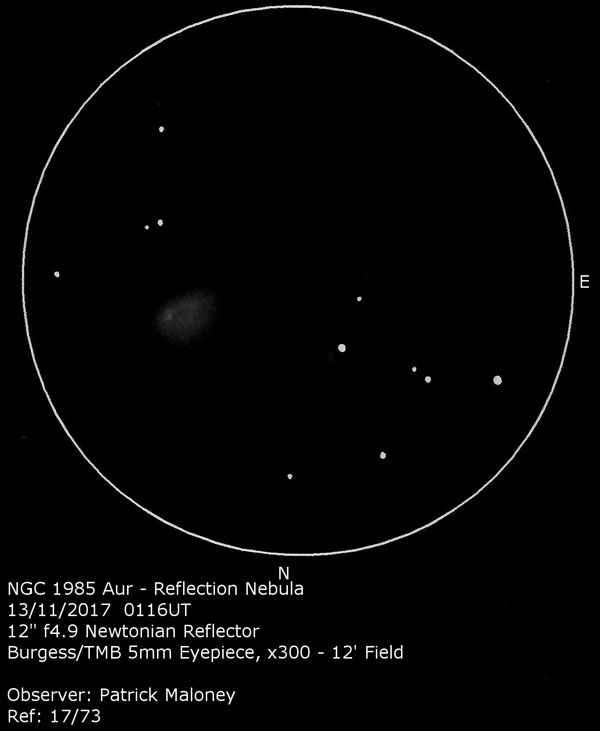
A sketch of NGC 1985 by Patrick Maloney through his 12-inch newtonian telescope at x300 magnification. I found that it was small but visible to direct vision. There was a bright spot with an almost triangular-shaped fan of nebulosity stretching away from it. I also noted that the view was better without a UHC filter.
On this last issue, the observing notes in the Night-Sky Observer’s Guide made from observations with a 12/14” telescope reads
Faint but visible without filters.
Object RA Dec Type Magnitude NGC 1907 05h 28’ 05” +35° 19’ 32” Open cluster 8.2 NGC 1985 05h 37’ 48” +31° 59’ 20” Reflection nebula 12.8 -
NGC 957 and IC 351 in Perseus
November 2022 - Nebula and Cluster of the Month
Our cluster for this month lies close to the double cluster in Perseus (NGCs 869 and 884, or h and χ Persei). In fact, it’s the closest open cluster to the pair, lying just 1.5° to the ENE.
It was discovered by John Herschel in 1831. He entered it in his catalogue as JH 227, and it subsequently entered the General Catalogue as GC 555, and finally in 1881 in the New General Catalogue as NGC 957. The description in the NGC is fairly basic: Cluster, pretty large, pretty rich, stars mag 9–15.

An image of open cluster NGC 957 provided by Velimir Popov and Emil Ivanov (IRIDA Observatory). Although the NGC description is accurate, as far as it goes, it’s always worth having a look for yourself. Pretty large? It’s usually quoted at 11–12’ across. Visually I estimated 10’ through my 12” (300mm) Newtonian at x81. Deeper images tend to show a slightly wider spread of faint stars than can be seen easily visually. Pretty rich? Descriptions vary. The Trumpler classification usually quoted for the cluster is III2m, which translates as ‘no discernible central condensation, detached, moderate range of brightnesses, medium rich (50-100 stars)’. Visually I counted about 40, with no determination of membership, of course. Steve Coe, in his published observations, describes it as ‘not rich’. I described it as ‘moderately rich’. This is the joy of visual deep-sky observing. You make of it what you will, and no two observations are ever quite the same.
The Deep Sky Field Guide to Uranometria 2000.0 gives the number of stars as 30 with the magnitude of the brightest star being 9.5. Archinal & Hynes in their Star Clusters give the star count as 112 with the brightest star being of magnitude 11.9. No two textbooks are ever quite the same, either. A paper1 by A. Giménez and J. García-Pelayo of the Instituto de Astrofisica de Andalucia in Spain lists photometric measurements for 212 stars in NGC 957. 91 of these stars are listed as ‘probable members’. This presumably leaves 121 certain members. Again, it’s always worth having a look yourself.
The cluster lies at the end of a little curl of bright, eighth-magnitude stars, which I guess are not members. It’s quite an attractive cluster, elongated more or less east-west and well populated with fairly bright stars. HD 15690, on the southern edge of the cluster, is a bright, easy double. With magnitudes of 8.0 and 9.7, this is presumably not a true member of the cluster. The Spanish measurements place NGC 957 at a distance of 1,150 parsecs (about 3700 light-years) so well within the Perseus Arm of the Galaxy.
This month’s nebula is a little planetary nebula, IC 351, still in Perseus. Discovered by Barnard in 1890, it is described in the Index Catalogue as appearing like a tenth-magnitude star. Like other brief catalogue descriptions, this is true as far as it goes. It’s always worth investigating these ‘stellar’ planetary nebulae because quite often they are not truly stellar.
Magnitudes cited for this object are around 11.9 to 12.0. The diameter is something between 7 and 12” (sources vary). The central star, when mentioned at all, is suggested to be a very difficult magnitude 15.8.

An image of planetary nebula IC 351 provided by Thomas Riessler. Observations quoted in the Night Sky Observer’s Guide suggest that in telescopes as small as 8” (200mm), a tiny disc can be perceived, whilst with objectives of 16–18” (400-450mm), the nebula can be clearly seen to be elongated. My own observation, made with a 12” (300mm) reflector tends to confirm this.
I observed IC 351 in December 2013 under very poor skies. Especially at lower altitudes, the sky was a sickly mustard colour. The whole sky was covered by thin, hazy, high cloud and I was under the impression that most of the time I was observing through it. At the time of the observation, IC 351 was at a healthy altitude of 72°, so minimising the effects of the poor sky.

A sketch of IC 351 by Patrick Maloney through his 12-inch newtonian telescope at x375 magnification. I observed a tiny disc that looked quite bright. A brighter section was possibly detected in the southwest quadrant of the object. Using the SP10mm eyepiece + 3x Barlow lens (giving a magnification of x450) it looked non-homogeneous. An outer envelope was suspected, as was a slight elongation. I also noted that the object did not seem to respond to the OIII filter.
Altogether a much more satisfying view than would be expected from the terse IC description.
It’s always worth looking.
Object RA Dec Type Magnitude NGC 957 02h 33’ 17” +57° 33’ 14” Open cluster 7.6 IC 351 03h 47’ 33” +35° 02’ 47” Planetary nebula 11.9 References:
- Astron. Astrophys. Suppl. Serv. 41, 9-12 (1980)
-
NGC 129 and Riddle 4 in Cassiopeia
October 2022 - Nebula and Cluster of the Month
This month, we’ll look at two open clusters; one obvious, the other a little less so. We’ll start with one discovered by our old friend William Herschel. On 16th December 1788, he swept up a cluster in Cassiopeia that he described as
A coarsely scattered cluster of large stars mixed with smaller ones, not very rich
. He entered it into his eighth class – coarsely scattered clusters of stars – as no. 79. It was included in John Herschel’s Slough Observations as JH 23 and in the General Catalogue as GC 63. In 1888 it entered the New General Catalogue as NGC 129. Its description in the NGC readsCluster, very large, pretty rich, little compressed, stars 9 – 13
.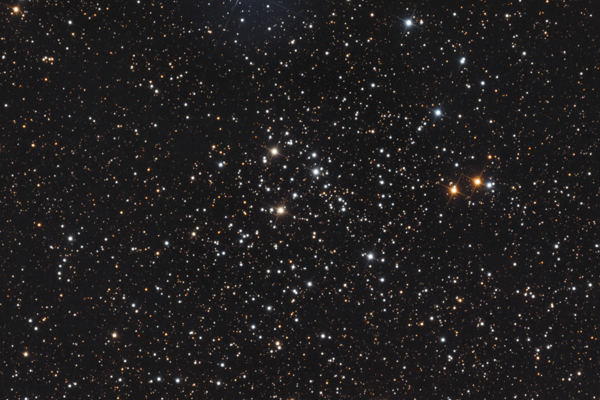
An image of open cluster NGC 129 provided by Bob Franke. This large, obvious cluster lies almost exactly halfway between β and γ Cas, and with an integrated magnitude of 6.5 is a fairly easy binocular target. Estimates of its angular size vary from 12’ (Archinal & Hynes) to 21’ (Night Sky Observer’s Guide, Deep-Sky Field Guide). Visually speaking, a diameter of 12’ is a much better fit than 21’. The figure quoted for the number of member stars varies considerably too, from 35 (Deep-Sky Field Guide) to an optimistic 193 (Archinal & Hynes). Visually, again, the number looks to be 40–50 stars.
The brightest star, at the centre, is a variable star designated DL Cas. It is a δ Cepheid variable with a range of 8.63–9.26 in an interesting period of eight days and 58 seconds. Confusingly, Archinal & Hynes give the magnitude of the brightest star as 11.0.
Estimates of distances to the cluster are equally vague. Archinal & Hynes quote a very precise 1589 pc (almost 5200 light-years). In 1992, Turner et al1 determined the distance to be 1670±13 pc (5447±42 light-years), whereas Gieren et al2 in 1994, using the standard-candle Cepheid calculation on DL Cas, obtained a distance of 2034±110 pc (6633±359 light-years). What we can say with some certainty is that NGC 129 lies beyond the Orion Spur in which the Sun resides, and is seen against the background of the Perseus Arm, though it isn’t far enough away to lie within that arm of the galaxy.
Through the eyepiece, three bright stars in a triangle define the centre of the cluster, and all of these are within an arc made up of the brightest stars in the cluster. Many other fainter stars can be seen. I have made observations of this cluster on two occasions, separated by three years. My notes match the historical descriptions pretty well – well detached, little central concentration and a moderate range of stars. The Trumpler classification I derived from this was III2m, which is matched in the sources I have to hand.

A sketch of NGC 129 by Patrick Maloney through his 12-inch newtonian telescope at x150 magnification. The second cluster I’m going to discuss this month is a much smaller and fainter object. It is again located in Cassiopeia, but for once was not spotted by the great visual observers of old. That’s not a huge surprise. Riddle 4 doesn’t seem to be plotted on any star atlas (I don’t have Millennium, maybe somebody could check that for me). It’s not listed in any source I have, except the slightly obscure Optically Visible Open Clusters Catalogue. Even in that, I can only find two clusters with Riddle designations: Riddle 4 and Riddle 15.
Riddle 4 lies amongst the great mass of open clusters that define the Milky Way as it passes through Cassiopeia, though compared to its nearest neighbours, Stock 2 (almost a degree in diameter) and NGC 734 (just 6’ in diameter), it’s a real tiddler. It is a tiny curl of stars 30 or 40” in diameter. That’s about the same apparent diameter as Jupiter.
Its distance has been determined by Bisht et al3 as 2.8&plusmin;0.2 kpc (approximately 9000 light-years) and its age at 40&plusmin;10 million years. The distance likely places it within the Perseus Arm of the galaxy.
I observed this little cluster with my 12” (300mm) reflector at varying magnifications. The drawing was made at x300, a 12’ field. My notes read
Absolutely tiny. 6 or possibly 7 stars of magnitude 13.5 – 14.7
.
A sketch of Riddle 4 by Patrick Maloney through his 12-inch newtonian telescope at x300 magnification. Object RA Dec Type Magnitude NGC 129 00h 30’ 00” +60° 12’ 43” Open Cluster 6.5 Riddle 4 02h 07’ 11” +60° 13’ 51” Open Cluster Br* = 13.0 References:
- ‘Galactic Clusters with Associated Cepheid Variables II – NGC 129 and DL Cassiopeiae’: Astronomical Journal 104(3): 1132-1143.
- ‘Independent distance determinations to Milky Way Cepheids in open clusters and associations. 1. The binary Cepheid DL Cas in NGC 129’: Astronomical Journal 107(6): 2093-2100.
- ‘Photometric study of open star clusters in II quadrant: Teutsch 1 and Riddle 4’: New Astronomy 42, July 2015.
-
NGC 7281 and NGC 7261 in Cepheus
September 2022 - Nebula and Cluster of the Month
This month we’re going to look at two objects, which may together be considered as an ‘Unsung Double Cluster’. Of course, it’s not as bright or spectacular as the famous Double Cluster in Perseus (NGCs 869 and 884), but it’s nice to come across two objects that can fit in the same low-power field.
NGC 7261 and NGC 7281 lie in Cepheus and are virtually overhead during September nights. Both were discovered by John Herschel, during his sweep number 215 on 5 October 1829. They first appeared in his 1833 catalogue as JH 2159 and JH 2161.
NGC 7261 – the smaller of the two – he described as
…a coarse, pretty rich cluster which fills the field. Stars 10–15 magnitude
whereas NGC 7281 wasLarge, coarse, not extremely poor, the stars scattered and 10 – 16 magnitude.
What exactly he meant by ‘not extremely poor’, is anyone’s guess, but it carries the whiff of damning with faint praise.The clusters lie 41’ apart, and will fit into a good, low-power field. Both are quite easily discerned against the background stars, despite neither of them being particularly bright or rich. Wide-angle photographs of the area show them, but they don’t stand out as clearly photographically as they do visually.
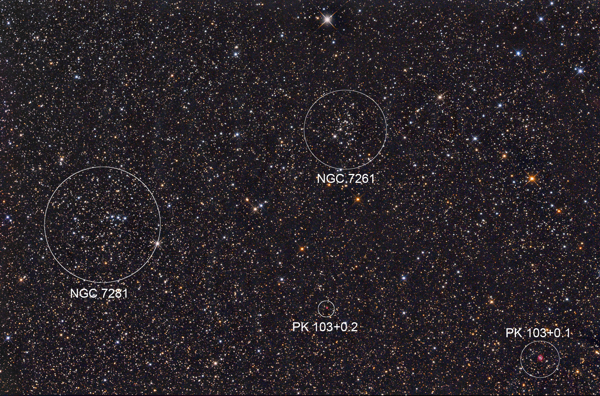
An annotated image of NGC 7281 and NGC 7261 provided by Gregg L. Ruppel. As ever, the Trumpler classifications of these objects vary from listing to listing, NGC 7261 variously being listed (amongst others) as II3m or III2p meaning ‘detached with strong central condensation (or little central condensation), a wide range of brightnesses with bright and faint stars (or only a moderate range), 50–100 stars (or fewer than 50 stars)’. Deep-Sky Field Guide (DSFG) quotes a membership of 30 stars, whereas Archinal & Hynes give 62. WEBDA has proper motion data for only two stars.
NGC 7281 fares a little better, being classed as IV2p or IV1p (Not well detached, moderate range of brightnesses (or most of the stars are of the same brightness), poor. The number of stars is generally given as 20, but WEBDA lists proper motions for 33 stars which are probably involved.
The question must be asked: are these two clusters actually physically associated, or are they simply in the line of sight of each other? The distances quoted on WEBDA for the clusters’ distances are 1681pc (about 5500 light-years) for NGC 7261 and 1620pc (about 5400 light-years). The error bars for these distances overlap each other, so a physical connection would, on the face of it, seem a possibility.
However, data from the Gaia mission renders a distance of 2119pc (6900 light-years) for NGC 7261, which would put it way behind NGC 7281. I have not seen any Gaia data for NGC 7281. Maybe that’s been pushed further out as well.
A further spanner in the works is that NGC 7281 is possibly not a true cluster at all. DSFG has the phrase ‘Probably not a cluster’ in its notes and this is passed on by Archinal & Hynes. The WEDBA data for 33 stars with comparable proper motions does seem to mitigate against this and support the case for 7281 being a true cluster. My own rather limited investigation suggests that none of the brighter stars in the immediate area share any proper motion. Certainly, the three brightest stars – which form an immediately obvious straight line – are all travelling in different directions and at different speeds, (see below).
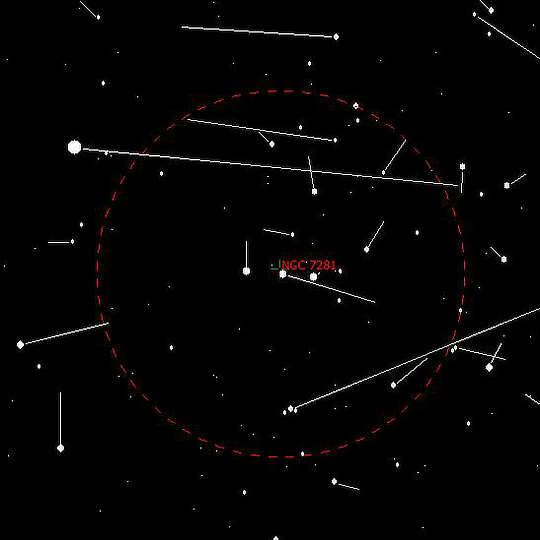
Proper motion vectors for NGC 7281 plotted with Guide 9 software. I have made a single observation of NGC 7261 and two of NGC 7281.
NGC 7261: With thin, high cloud covering the whole sky, this wasn’t an ideal night for observing. NGC 7261 appeared as small, well detached and somewhat concentrated. About 15 stars were seen through the thin cloud. It looks promising for a better night. The brightest stars form a quadrangle with the brightest star in the cluster (about mag 9.5) at its eastern point. (No drawing made).
NGC 7281(1): Small, not well detached and only moderately compressed. Maybe 20 stars seen over about 10'. The cluster is dominated by three 10th magnitude stars in a short straight line. (No drawing made).
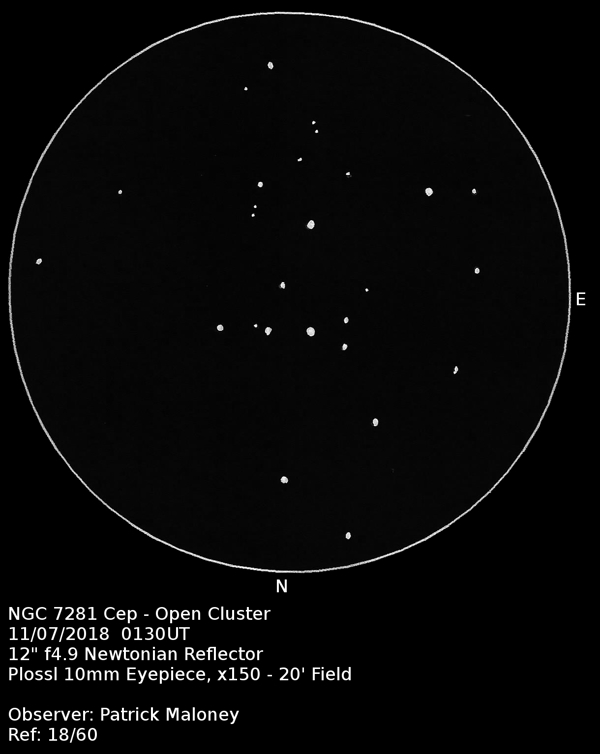
A sketch of NGC 7281 by Patrick Maloney through his 12-inch newtonian telescope at x150 magnification. NGC 7281(2): Shaped like a bent capital letter ‘T’. The three brightest stars, forming a straight line, are magnitude 10. The proper motions of these stars demonstrate that they are not physically connected. (Drawing 18/60).
Object RA Dec Type Magnitude NGC 7261 22h 20’ 10” +58° 06’ 35” Open Cluster 8.4 NGC 7281 22h 24’ 57” +58° 50’ 27” Open Cluster Br* = 10.2 -
NGC 7023 in Cepheus
August 2022 - Nebula and Cluster of the Month
The Milky Way still reigns supreme in the night skies of August, studded with deep-sky gems. This month we’ll be looking at an object that has been at the centre of a whole heap of confusion. Hopefully, by the end of this article, the confusion will be banished.
The object in question is a reflection nebula in Cepheus, NGC 7023. Point of Confusion no. 1 is that it is often listed as an open cluster. In the first edition of Uranometria 2000.0, it is listed as both an open cluster and a bright nebula. The open cluster entry reads
Involved in nebulosity which also carries the same designation’ and the bright nebula entry reads ‘Contains open cluster NGC 7023
. No.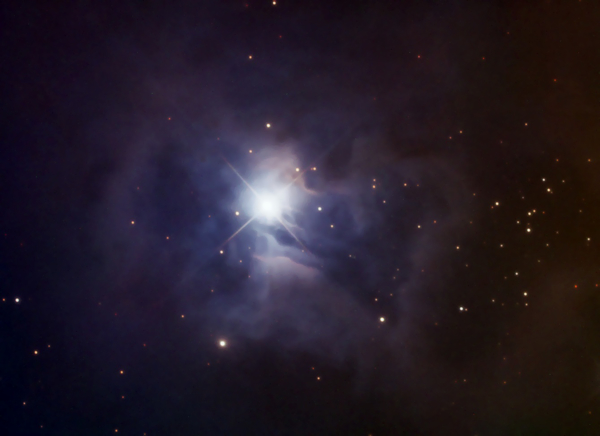
An image of reflection nebula NGC 7023 provided by Prof. Robert Vanderbei. First seen by William Herschel on 18 October 1791, he placed it in his fourth class (planetary nebulae – Point of Confusion no. 2) as no. 74. He describes it as
A star 7m very much affected with nebulosity, which more than fills the field. It seems to extend to at least a degree all around; smaller stars, such as 9 or 10m of which there are many, are perfectly free from this appearance.
Firstly, although NGC 7023 is not a planetary nebula by our modern definitions, there was no scientific definition of planetary nebulae per se at this time. In fact, it was Herschel himself who coined the phrase ‘planetary nebula’, to describe the visual appearance of certain objects that he saw. It was only in the following century that the term was applied exclusively in the way we do now.
Herschel’s description of many ninth and tenth magnitude stars may have led to the belief that he was describing an open cluster. However, he is only describing the rich field seen at lower powers and is using the presence of these other non-nebulous stars to highlight the nebulous appearance of the main star (now called V380 Cep, an Orion-type variable of early spectral type – B3 in this case – with a magnitude range of about 7.2 to 7.4).
Point of Confusion no. 3 is that there is an open cluster here. It was listed by the Swedish astronomer Per Collinder as Cr 427. It is a small, loose cluster centred about 5’ to the west of V380 Cep. Its brightest member star is magnitude 15.6, so it’s unlikely to trouble most visual observers. It is expressly not catalogued as NGC 7023.
Point of Confusion no. 4 is that Collinder mistakenly listed this cluster twice. The second entry, Cr 429, was incorrectly equated by him with NGC 7023. Furthermore, (Point of Confusion no. 5) both the entries in his catalogue are positioned slightly too far to the west, putting Cr 429 in an utterly blank region 6’ west of Cr 427.
In his Atlas of Open Star Clusters (Volume 2 in the earlier edition), Mike Swann correctly positions Cr 427 within the nebulosity of NGC 7023.
These compounded errors have been duplicated in many catalogues, and are repeated ad nauseam across the internet. The real facts are that NGC 7023 is a reflection nebula centred on the seventh magnitude star V380 Cephei. 5’ to the west of V380 is a very faint open cluster Cr 427. NGC 7023 is not, and never was, the designation of an open cluster. Cr 429 does not exist as a separate object but is a slightly misplaced relisting of Cr 427.

A sketch of NGC 7023 by Patrick Maloney through his 12-inch newtonian telescope at x150 magnification with a UHC filter. Visually speaking, NGC 7023 is a quite striking object. The central star is surrounded by a circular disc of bright nebulosity and there are fainter nebulous fans stretching out east and west. The fan to the west is the brighter and contains much barely-glimpsed obscuration. The one feature that could be clearly seen and held is a straight line of dark material southwest of the bright central star. This is a prominent feature in images of the nebula. The fan of nebulosity to the east of the central star is fainter, and no certain dark features could be discerned. I found the use of a UHC filter helped considerably with this object.
Herschel’s description of the nebulosity spreading ‘at least a degree’ is an exaggeration. My observation shows the longest dimension to the nebulosity of about 7’. Images can double this, but the outer nebulosity is very faint.
Object RA Dec Type Magnitude NGC 7023 21h 01’ 37” +68° 09’ 55” Reflection nebula 7 Cr 427 = Cr 429 21h 00’ 36” +68° 09’ 46” Open Cluster Br* = 15.6 -
NGC 6756 in Aquilia
July 2022 - Nebula and Cluster of the Month
July brings the glories of the northern Milky Way to our midnight skies. Not so great for the obsessive galaxy-hunter, though there are still plenty shining through gaps in our local galaxy’s dust. It’s a good time for open cluster enthusiasts, though.
Our open cluster for this month, although listed in the Herschel 400 observing list, is a little-known object in Aquila, NGC 6756. It was discovered by our hero William Herschel on 21 August 1791. He placed it in his class VII – ‘Pretty much compressed clusters of large or small stars’, as entry number 62. On that occasion, he described it as
A pretty compressed cluster of stars not very rich
. (Phil. Trans. R. Soc. Lond. 1802 92)
An image of open cluster NGC 6756 provided by Pan-STARRS1 Surveys. William’s son John Herschel, a deep-sky observer at least as good as his father in my opinion, made four observations of the cluster which were published in his 1834 Observations of Nebulae and Clusters of Stars in which it received the designation JH 2031.
- Sweep 77:
Pretty compressed; irregular figure; 2’ diameter; stars 15th magnitude
. - Sweep 78:
Pretty compressed; Small; Round or irregular
. - Sweep 79:
Pretty compressed cluster; irregular figure
. - Sweep 278:
Pretty rich; Small; Much compressed; oval or rather fan-shaped. The stars 11..12 magnitude, 4’ in extent the north following side most compressed
.
These observations are pretty consistent with the glaring exception of the estimates of the constituent stars’ magnitudes. Somehow, they brightened from magnitude 15 to magnitude 11-12, an increase in brightness of at least 16 times!
The cluster made its way into John Herschel’s General Catalogue (GC) of 1864 as number 4471, where its description was given as
Cluster; small; rich; little compressed; stars 11..12
. It has degraded from the Herschels’ description of it as ‘pretty compressed’ to ‘little compressed’, and the magnitudes have been transferred as the much brighter estimate.When the General Catalogue was updated to the New General Catalogue in 1888, the cluster was listed as number 6756, and the GC description was retained.
What accounts for these seemingly irreconcilable differences? It depends on how you look at the object. As the photograph shows, NGC 6756 as a whole is about 4’ in diameter and generally is not very compressed. The two brightest stars in this 4’ diameter patch of sky are magnitudes 11.5 and 12.4. No other star is brighter than magnitude 13.3. These two stars are markedly different in their colour from the other stars in the cluster, though, and are therefore probably non-members lying between us and the cluster itself.
Closer inspection reveals a highly concentrated patch of stars to the northeast. Note John Herschel’s comment
...the north following side most compressed.
This area of the cluster is 1’ in diameter. This may be coincident with John Herschel’s earlier description of a cluster 2’ in diameter comprising 15th magnitude stars. The stars in this region are 14th to 16th magnitude and are very compressed.Modern catalogues give the cluster’s diameter as 4’ and the number of stars as 40, though there are over 100 stars brighter than magnitude 16.0 within the 4’ circle. Its distance is quoted as 1507pc, or a little short of 5000 light-years. Galactic dust absorbs 1.2 magnitudes, reducing the whole object to a magnitude of 10.6. I have found different age estimates for this cluster. WEBDA gives 62 million years, a figure widely quoted. However, in a paper1 investigating the occurrence of Be stars (young, non-supergiant B-type stars that display emission lines in their spectra) in open clusters, the age of NGC 6756 (which contains two Be stars) is given as 125-150 million years. According to the authors, this would make it the oldest open cluster known to contain Be stars. In this same paper, however, NGC 7039 is quoted as having one Be star and having an age of 1000 million years. I’ll leave you to figure that out for yourself.
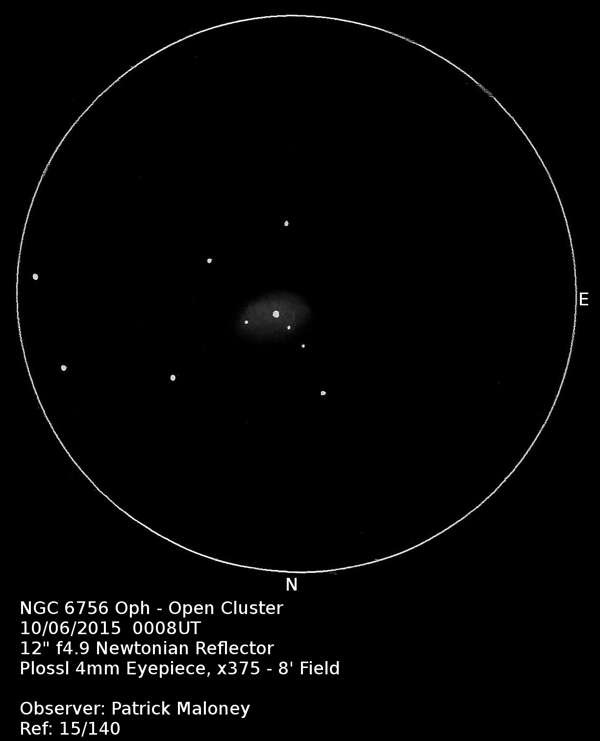
A sketch of NGC 6756 by Patrick Maloney through his 12-inch newtonian telescope at x375 magnification. Visually, this object is quite striking. I observed it through my 12” Newtonian reflector in June 2015, under less than perfect skies that were also suffering from the onset of morning twilight. I noted a bean-shaped curve of nebulous, unresolved stars. Some member stars were seen superimposed. These stars range from magnitude 14.2 to 14.5, about my limit for the brightening sky. The background of unresolved stars is quite bright and looks very much like a low-power view of a globular cluster.
It’s a cracking little object.
Object RA Dec Type Magnitude NGC 6756 19h 08’ 44” +04° 42’ 51” Open cluster 10.6 Reference
- Be phenomenon in open clusters: results from a survey of emission-line stars in young open clusters. Blesson Mathew, Annapurni Subramaniam and Bhuwan Chandra Bhatt. Mon. Not. R. Astron. Soc. 388, 1879–1888 (2008)
- Sweep 77:
-
NGC 6356 in Ophiuchus
June 2022 - Nebula and Cluster of the Month
June brings the shortest of our nights, but also the promise of better things, as the glorious northern Milky Way comes into prominence in the east, moving to its overhead passage in July. Although the June sky (defined for this column as objects that are at the meridian at midnight at some point during the calendar month) is not as packed as the July sky, there are still some objects worth seeking out.
June is particularly rich in globular clusters, with 30 NGC objects and one IC higher than declination -30° visible at meridian during the month, though it must be confessed that several of these are quite low in British skies.
Our object for this month is one of these globular clusters – not too low, not too high; not too easy, not too difficult. NGC 6356 lies in Ophiuchus, at a declination of close to -18°, and culminates at midnight on the 30th of the month. It is 2.8° south-east of the magnitude 2.5 η Ophiuchi, and 1.2° north-east of Messier 9.

An image of globular cluster NGC 6356 provided by Pan-STARRS1 Surveys. It lies about 50,000 light-years (15,000 pc) away and has a mass of around 600,000 suns. NGC 6356 is a relatively metal-rich globular cluster and was believed for some time to be particularly dust-rich, too. A study published in 1998 by Hopwood, Evans, Penny and Eyres (Mon. Not. R. Astron. Soc. 301, L30-L32 (1998)) determined the quantity of dust in the cluster to be of the order of 0.004–0.017 solar masses, less than was expected for the cluster’s escape velocity, which they quote as 35.6 kms-1.
As with so many of the objects featured in this column, it was first discovered by William Herschel, who spotted it on 17th June 1784. On that occasion, he described it as
Bright. Large. Round. Gradually brighter towards the middle. Easily resolvable.
When reading Herschel's descriptions, we need to take two things into account. Firstly, he made most of his observations with an 18” (500mm) reflector, considerably larger than most amateur instruments today, and he did not suffer from light pollution. Both these factors tend to make his descriptions slightly ‘optimistic’ from the point of view of a light-polluted amateur observer of today. However, NGC 6356 is fairly bright, though not very large (depends what you’re comparing it to, I suppose). One thing it certainly isn’t is ‘easily resolved’. The brightest star is magnitude 15.1, making this a tough one to resolve unless you have good skies and a telescope of over 14” (350mm) diameter.
The magnitude quoted for this object in nearly all sources is either 8.2 or 8.4. That does, indeed, make it fairly bright. Even more importantly, it is very concentrated, being classified as a II on the I–XII Shapley-Sawyer concentration scale. This indicates a dense central condensation. For comparison, the bright globular cluster M2 has this same level of concentration.
The diameter of the cluster is usually given as 7.2’, though this takes into account the furthest stragglers. It actually appears considerably smaller than this. Through the eyepiece, expect a diameter of 2’–3’.
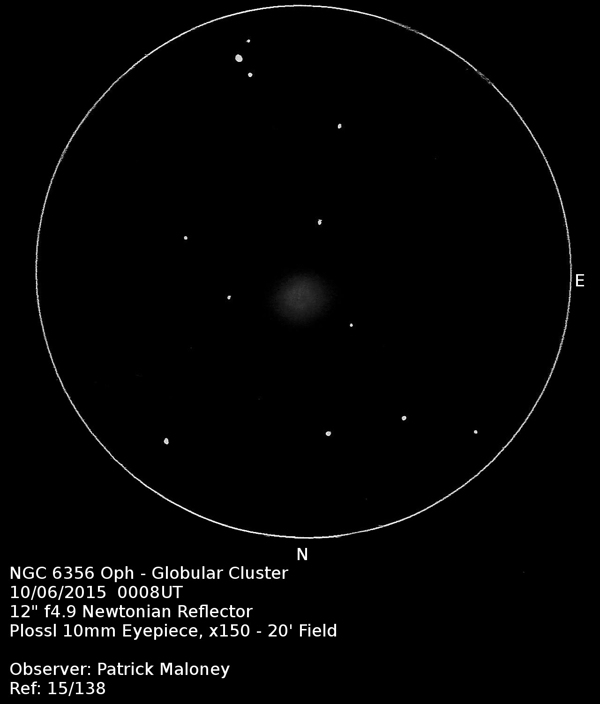
A sketch of NGC 6356 by Patrick Maloney through his 12-inch newtonian telescope at x150 magnification. I made an observation of NGC 6356 on 10th June 2015 with a 12” Newtonian reflector from my suburban site. I noted that it appeared bright, small and round. I also recorded that I thought I was only seeing the central section (which was true) and that there was no sign of resolution. This is hardly surprising with the brightest stars being 15th magnitude; the faintest stars I recorded on my drawing were between 11th and 12th magnitude.
The resolution of this object is a good test of your conditions and your instrument.
Object RA Dec Type Magnitude NGC 6356 17h 23’ 35” -17° 48’ 47” Globular cluster 8.2 -
IC 4593 in Hercules
May 2022 - Nebula and Cluster of the Month
May brings with it, we hope, warmer weather and the real promise of sunny days. What is more certain is that for those of us in northern temperate zones it brings the end of astronomical darkness for some weeks to come. The centre of Britain sees astronomical darkness for only 22 minutes on the night of 12/13 May. The following night there is none, and it will not be seen again until 31 July, when we get 26 minutes.
The occurrence of astronomical darkness is these days more theoretical than practical. Most of us live all year under perpetual artificial twilight, so we should be used to dealing with it, and unless you live in the far north, you really have no excuse for putting the telescope in storage for 10 weeks.
This month, then, we’re going to concentrate on an object that is easy to see, even under twilight, but can be difficult to pick out in a low-power field. High power is needed to get the best view.
May’s object is a small planetary nebula in Hercules, IC 4593. It is very bright – magnitude 10.7 – so should be easily seen by all but the smallest telescopes. Recognising it for what it is will require higher power.

An image of planetary nebula IC 4593 provided by NASA, ESA, and The Hubble Heritage Team (STScI/AURA). It was discovered on Harvard photographic plates by Williamina Fleming in 1907 and bears her designation Fleming 108. The entry in the Index Catalogue is typically terse:
Planetary, stellar
.NASA quotes a distance for IC 4593 of between 7000 and 8000 light-years (2150 - 2450pc), though other estimates range from 3000 to 12000 light-years. Assuming a diameter of one light-year (about average for a planetary nebula), the distance should be about 5000 light-years. Planetary nebulae distances and diameters are notoriously uncertain.
Images of the nebula show a bright inner region and a much fainter, much larger outer envelope. The object also displays what appear to be bipolar jets with brighter blobs of material at the ends, which look very similar to the famous ‘ansae’ (Latin; ‘handles’) of NGC 7009.
In 2012, observations made with the Chandra X-Ray telescope led to the discovery of a ‘hot bubble’ around the central star of IC 4593 (Monthly Notices of the Royal Astronomical Society, Volume 494, Issue 3, May 2020, Pages 3784–3789). This is not the only hot bubble detected in a planetary nebula by Chandra, but is so far the most distant.
IC 4593 is not the easiest object to locate. It lies in the southwest of Hercules, close to the border with Serpens, in a relatively barren region of sky.
The brighter central part, which is all that you’re going to see visually, is about 29” in diameter. The central star, of spectral type O0, is magnitude 11, and easily visible, and can be well seen in low finding powers. You may have to inspect a few stars in the field on high power before picking out the right one. Some observers of planetary nebulae can pick out a stellar planetary nebula even with low power. There’s something about the quality of the light from these objects that draws the eye. I’ve found this to be so on several occasions. This is a good one to test the effect out on.
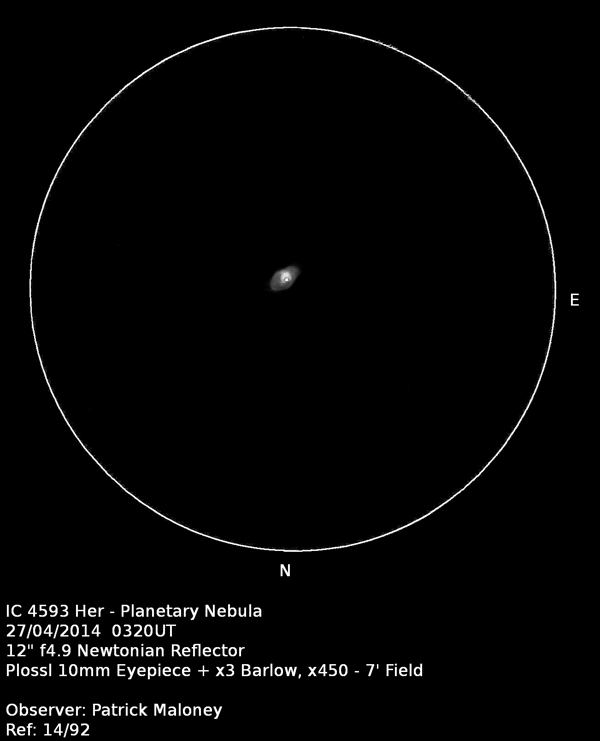
A sketch of IC 4593 by Patrick Maloney through his 12-inch newtonian telescope at x450 magnification. High power reveals a circular bright disc, with an elongated outer envelope (not the really faint one visible in images) that stretches away from the bright inner part like wings. I found that the object was still stellar at x83, but when I cranked the magnification up to x450, a fair amount of detail could be seen. To my eyes, the effect of the OIII filter was marginal. At high power, the object is isolated in the field with no visible field stars. There is a 9.4 magnitude star 5’ to the northwest, just outside my high-power field. In common with several other observers, I see a very clear blue colour in this object. The bright central star appeared to be oddly off-centre.
Object RA Dec Type Magnitude IC 4593 16h 11m 44s +12° 04’ 17” Planetary nebula 10.7 -
NGC 5053 in Coma Berenices
April 2022 - Nebula and Cluster of the Month
In the northern hemisphere, April is a time for observing galaxies as the great galaxy fields of Leo, Coma and Virgo straddle the meridian. Yet April also brings some examples of another class of objects into view. Globular clusters. The brightest of these for northern hemisphere observers (for in the south, the glorious Omega Centauri also culminates this month), is Messier 53. This is a lovely object, well seen even in small telescopes.
However, it is not M53 that we’re going to concentrate on, but its neighbour, NGC 5053. First observed by William Herschel on 14 March 1783, he described it as
An extremely faint cluster of extremely small stars with resolvable nebulosity. 8 or 10’ diameter. Verified [with a magnification of] 240. Beyond doubt.
He placed it in his sixth class of objects – ‘very compressed and rich clusters of stars’ as entry no. 7.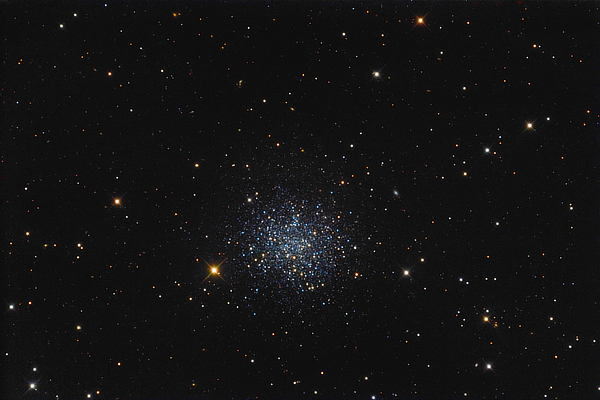
An image of globular cluster NGC 5053 provided by Bob Franke. Click this link for a larger version of this image in a new tab. NGC 5053 lies less than a degree southeast of M53. The distances of the two globulars are very similar, from which it has been calculated that they lie only about 2kpc (6,500 light-years) apart. Evidence that the two globular clusters have interacted in the past is presented by a tidal stream of stars that connects the two.
Chemically, the stars of NGC 5053 have low metallicity, that is, they are poor in elements heavier than Helium. The chemical composition of the member stars is very similar to that of the stars of the Sagittarius Dwarf Spheroidal Galaxy (SDSG) and far less akin to those of stars in the Milky Way’s halo. Studies of the spatial velocity of the globular cluster add weight to the argument that NGC 5053 was originally a globular cluster of the SDSG, and not of the Milky Way at all.
Whilst M53 may present little difficulty to the visual observer with a small telescope, NGC 5053 is a completely different matter. It is fainter than M53, magnitude 9.9 as opposed to M53’s 7.7. It is also slightly smaller, with a diameter of 10.5’ compared to M53’s 12.6’.
Finally, and much more importantly, whilst M53 has a concentration class of V, NGC 5053’s concentration class is XI, making it a very loosely compacted cluster. I’ve said it before and I’ll say it again, the most important metric for determining the visibility of a given globular cluster is its concentration class.
All this means that seeing NGC 5053 can be tricky. When searching for a low-concentration globular cluster, it’s best not to expect to see a fuzzy ball, as brighter ones tend to appear at low magnification. It’s far better to search for a scatter of very faint stars, although on a good night NGC 5053 itself does present as a faint fuzzy patch. With my 12” Newtonian reflector, from an admittedly poor sky location, I certainly did not see it the first time I looked. When I looked for it after the sky had been washed by a particularly heavy rainfall, I finally saw it.

A sketch of NGC 5053 by Patrick Maloney through his 12-inch newtonian telescope at x150 magnification. I saw a large, circular patch of dim nebulosity. There was no indication of brightening towards the centre (typical of low-concentration globulars). It looked more like a ghostly grey patch. Three stars were bright enough to be plotted. It turns out the brightest star in the cluster is magnitude 13.8. Other stars were seen, or glimpsed, but never clearly enough or for long enough to plot.
Object RA Dec Type Magnitude NGC 5053 13h 16m 27s +17° 41’ 55” Globular Cluster 9.9 -
Messier 97 in Ursa Major
March 2022 - Nebula and Cluster of the Month
For the same reasons as outlined in last month’s feature, I find myself somewhat bereft of objects to write about for this month.
I’m therefore going to concentrate on a single object, NGC 3857, alternatively known as Messier 97, PK 148+57.1 and PN G 148.4+57.0.

Messier 97 (NGC 3587) by NOIRLab/NSF/AURA. M97 lies in Ursa Major, 2.3° ESE of β Ursae Majoris (Merak), the bottom right-hand star of the bowl of the Plough.
It was first seen by Pierre Méchain on 16 February 1781. His friend Charles Messier then observed it for the first time on 24 March of that year. He wrote of his observation:
Nebula in Ursa Major, near beta. “It is difficult to see”, reports M. Méchain, “especially when one illuminates the micrometer wires: its light is faint, without a star.” ... Near this nebula he saw another which has not yet been determined, also a third near gamma Ursae Majoris. Diam 2’.
The two other ‘nebulae’ discovered by Méchain are almost certainly NGC 3556 and NGC 3992. In fact, so secure are these identifications that these two galaxies have now been designated as M108 and M109, even though they never actually made it into Messier’s catalogue.
The Herschels, father and son, both observed the object, William describing it as
A globular body of equal light throughout
and John asDiam. 2’40”, light equable, with a softened edge and fairly bi-central.
Lord Rosse observed it with his 72” Leviathan, writing that it was
Two stars considerably apart in the central region; dark penumbra around each spiral arrangement.
Kenneth Glyn Jones notes of this observation that on many occasions only one star was seen and the spiral form was doubtful.
Messier 97 (NGC 3587) William Parsons, the Third Earl of Rosse. The reference to two stars is problematic. There are actually three stars visible in the nebula. One is the central white dwarf, and the others are line-of-sight objects. They are not in the locations shown on Rosse’s charming and somewhat comical illustration. Thomas Romney Robinson, Director of the Armagh Planetarium, and inventor of the four-cup anemometer, observed M97 through Rosse’s telescope in 1848. He describes
A most intricate group of spiral arcs disposed round two starry centres, looking like the visage of a monkey.
Our own Rev. T. W. Webb in his Celestial Objects for Common Telescopes, adds something to the story:
Large, pale planetary nebula. Very remarkable object: two stars, one in each opening – only one seen since 1850.
Are these just mistaken observations? The ‘voids’ in the planetary nebulae are not centred on stars, as these 19th-century observers would have us believe. It’s easy to misplace a star, especially an extremely faint one, when making an observation. They fade in and out of sight and it can be very difficult to place them directly where they actually lie. The brightest of the three stars in the nebula is the central white dwarf, magnitude 16 (or is it? – see later) and the second brightest is magnitude 17.
M97 is one of the closer planetary nebulae to us, lying about 2000 light-years away. It consists of (at least) three concentric shells of nebular material, and expansion data indicates that it began expanding, at the time of the central star’s collapse into a white dwarf, about 8000 years ago. Its current diameter is a little less than one light-year and it contains 0.13 solar masses of material.
I have made two observations of this object, both reproduced here. Firstly with a 4½” (11cm) reflector in 1979 and then again in 1995 with a 12” (300mm) reflector. The observation made with the smaller telescope was made under dark sky conditions and demonstrates that the planetary is visible in small telescopes if the conditions are right. Kenneth Glyn Jones (KGJ) in Messier’s Nebulae and Star Clusters writes
M.97 is a fairly difficult object to find as it is small and faint and will probably elude instruments smaller than 6-inches aperture.
He was observing with an 8” (200mm) reflector, but his observation shows a field of 65’. Higher power is much better for planetary nebulae. The tired old maxim that deep-sky objects demand wide-field low powers is a much-regurgitated myth.Through my little 4½” ‘scope, I saw
...a large, bright disc of non-homogeneous light. Indistinct dark and light patches appear briefly before disappearing once again into the overall glow. A very noticeable feature of the nebula is the absence of a faint periphery. ... M97 has a very definite edge. A star of about mag 11 is very close Nf.
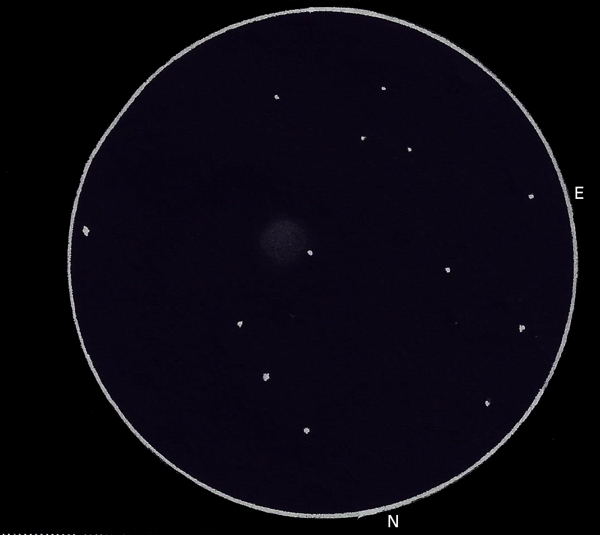
A sketch of Messier 97 (NGC 3587) by Patrick Maloney through his 4.5-inch newtonian telescope in 1979. The central star is widely quoted as having a magnitude of 16 (very specifically in Uranometria as 16.01). In my observation of 1995, I have placed the central star where I saw it. KGJ states that the central star is of magnitude 14. If it was really a 16th mag. object, I doubt I would have seen it. My estimate was about 15, as it was just occasionally glimpsed. I noted the planetary’s large size and brightness. The brightness over the disc was irregular, and darker incursions were seen on both sides of the object.
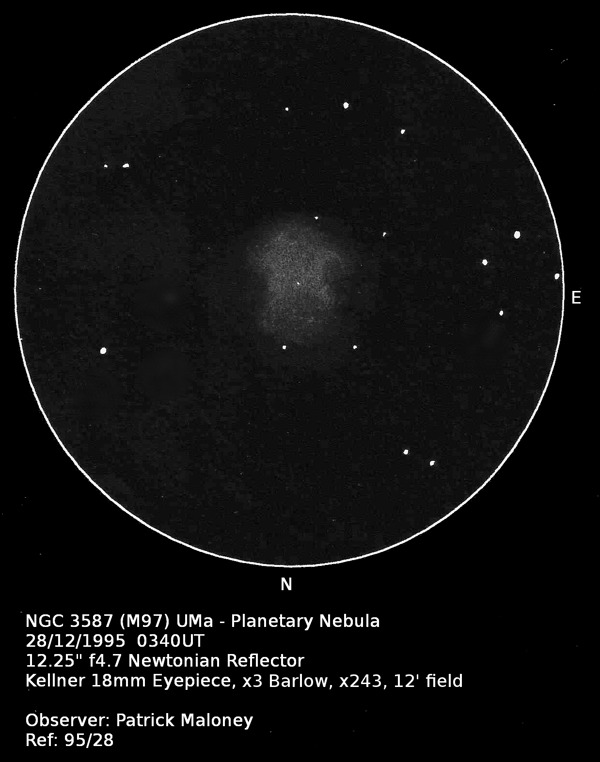
A sketch of Messier 97 (NGC 3587) by Patrick Maloney through his 12-inch newtonian telescope at x243 magnification. The Night Sky Observer’s Guide – Volume 2 Spring & Summer states that
This planetary’s disk is about the same diameter as Jupiter’s disk...
The diameter of M97 is 194” as opposed to Jupiter’s maximum of about 50”. This jarringly incorrect statement, made almost immediately after the diameter of the object is correctly quoted, had me scratching my head for a while until I came across the description given by Admiral W. H. Smyth in his Cycle of Celestial Objects (1859). He says
This very singular object is circular and uniform and after long inspection, looks like a condensed mass of attenuated light seemingly the size of Jupiter.
It seems that this is another astro-myth being repeated without being checked. It just goes to show that even the most highly-regarded texts can sometimes be misleading.
Object RA Dec Type Magnitude M97 11h 11m 48s +55° 01’ 09” Planetary nebula 9.9v, 12.0p -
Open Cluster Classification
February 2022 - Nebula and Cluster of the Month
The criteria I use for nebulae and clusters to be included for a particular month are that they should culminate within an hour of midnight on some date during the month. This effectively means that the Right Ascension (RA) of the object must lie within a two-hour band. I also tend to favour objects north of -30° declination.
I have in the past struggled with February. There are really only two open clusters of any note in February’s RA band – Messiers 44 and 67, in Cancer. Both these objects are so well known that they fail to make my other criteria – that they should be good but obscure objects, or that I have something interesting to say about them.
Nebulae are equally absent in February. I find myself therefore in a bit of a quandary, so this month I’m going to discuss how we categorize open clusters. I frequently quote the Trumpler classification for the open clusters that I discuss, but what exactly do those classifications mean?
The first person to attempt to classify open clusters was probably our old friend William Herschel, who gathered his deep-sky discoveries into eight different catalogues. Catalogues VI, VII and VIII were for open clusters of differing visual appearance. VI was for ‘very compressed and rich clusters of stars’, VII was for ‘pretty much compressed clusters of large or small stars’, VIII was for ‘coarsely scattered clusters of stars’.
A later, though barely more complex, system was introduced by Harlow Shapley. He suggested eight classes: (a) – field irregularities, (b) – star associations, (c) – very loose and irregular, (d) – loose and poor, (e) – intermediate rich, (f) – fairly rich and (g) – considerably rich and concentrated.
A class (a) object could simply be a statistical irregularity within a certain patch of sky, slightly more stars than would be expected on average. Class (b) objects would include such systems as the Ursa Major moving group. Shapley included the Hyades and the Pleiades in his class (c), M21 and M34 in class (d), M38 in class (e), M37 in class (f) and M71 (a globular cluster) in class(g).
Enter Robert Trumpler, who recognised that open clusters had more complex morphologies than could be described in Shapley’s system. He broke his classification system into three distinct properties: concentration/detachment, the range of brightnesses of stars within the cluster and the richness (number of stars) of the cluster.
The word ‘detachment’ refers to how easily differentiated from the background star field the cluster is. Obviously, this is closely allied to, but not wholly dependent on its concentration.
The concentration or detachment part of the classification is given first, in Roman numerals.
- I
- Detached clusters with strong central condensation
- II
- Detached clusters with little central condensation
- III
- Detached clusters with no discernible central concentration
- IV
- Clusters not well detached from the surrounding star field
The range of star brightnesses is given next, in Arabic numerals:
- 1
- Most stars are of similar magnitudes
- 2
- There is a moderate range in brightnesses
- 3
- The cluster is composed of both bright and faint stars
The third part of the classification refers to the richness of the cluster, defined by the number of members. This is given as a lower-case letter:
- p
- poor (fewer than 50 stars)
- m
- medium (between 50 and 100 stars)
- r
- rich (more than 100 stars)
These categorizations are determined usually by a visual inspection of a photograph of the cluster. If there is nebulosity associated with the cluster, then an additional ‘n’ will be placed after the richness indicator.
The system is flexible but is beset with problems. How for example, does one define how strong the central condensation is? What exactly does ‘moderate range’ mean for brightnesses, and how can you be sure how many stars in the field are cluster members?
This inevitably leads to differences in quoted Trumpler types from different sources. I’ve pointed some of these out in previous months. When I make an observation of an open cluster, I tend to have a go at assigning a Trumpler classification based on my observation, rather than on what may be seen on a photograph or image. This can be a fun addition to the process, and I recommend it to you. It can improve your observing technique as you try to classify the object in your field of view, making you look ever more closely and critically.
Have a look at this image of NGC 1245 in Perseus.

An image of open cluster NGC 1245 provided by Gregg Ruppel. Click this link for a larger version of this image in a new tab. The following Trumpler classifications are given to it just in books that happen to be on my desk at the moment:
- II2r
- III1r
- III2r
- III3r
At least everyone agrees that it’s a rich cluster, but does it have little central condensation (II) or no discernible central condensation (III)? Where, for that matter, is the centre, exactly? Are the stars all the same magnitude (1), of moderate range (2) or with both bright and faint stars (3) (but the range isn’t ‘moderate’, whatever that means)?
I have my own opinion; I’d be interested to hear yours.
-
NGC 2264 in Monoceros
January 2022 - Nebula and Cluster of the Month
Firstly, I would like to wish you a happy new year. We’ve had a couple of tough ones, so let’s hope for some highly visible improvements this year.
To start the new year, I’m going to be looking in some detail at a single object that incorporates both nebula and cluster. Located in Monoceros, nine degrees north of the celestial equator, it is easily accessible to observers in both the northern and southern hemispheres.
The nebula and the cluster, both now referred to as NGC 2264, were first observed by William Herschel. He found the cluster first, on 18 January 1784, describing it as
Double and attended by more than 30 considerably large stars.
Evidently, Herschel did not see the nebulosity in which this cluster is wreathed until he revisited the object nearly two years later, on 26 December 1785. On that night, he noted
Some bright stars 7 or 8' south preceding 15 Mon are involved in extremely faint nebulosity which loses itself imperceptibly.
It reads as though he was unaware that he had previously observed the cluster. He gave the cluster the designation 8 H.VIII, including it in his eighth class – ‘Coarsely scattered clusters of stars’, whilst giving the nebula the designation 27 H.V, placed in his fifth class – ‘Very large nebulae’.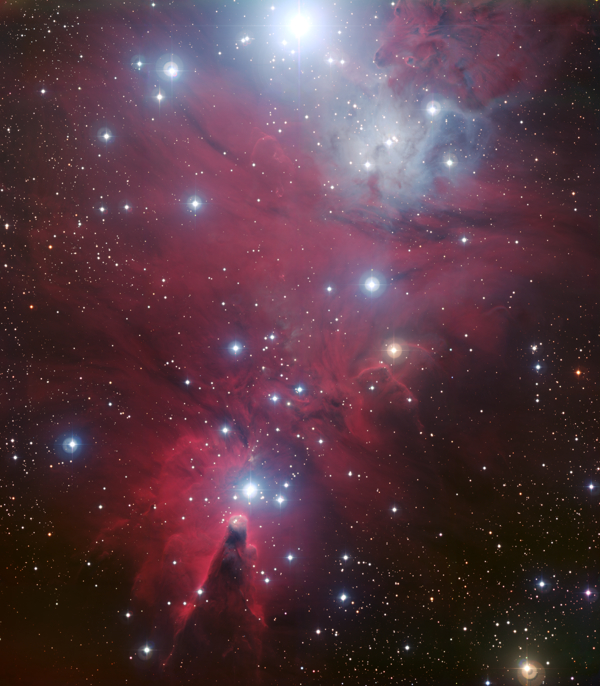
NGC 2264 and the Christmas Tree cluster provided by ESO. The first word in the description of the open cluster – ‘Double’ – refers to the star he used as the basis for the position he gives for the cluster, 15 Monocerotis. 15 Mon is a double, but more than that, it’s the principal star in a complex multiple star system, the relationships between which are the subject of no fewer than 28 entries for 17 different stars in the Washington Double Star Catalogue. Seven of these stars are double or multiple stars in their own right.
15 Mon also bears the variable star designation S Mon. The variations are slight, from magnitude 4.62 – 4.68. S Mon is a young star with a spectral type of O7e. It has an absolute magnitude quoted from -2.6 to -5.1, which is confusing and unhelpful. Its mass is around 30 solar masses. The distance is problematic, with ground-based dynamical parallax and isochrone measurements consistently giving a distance of between 700 and 900 parsecs (2300–3000 light-years), whereas Hipparcos parallax measurements suggest a distance only half this.
The age of the cluster is between three and five million years.
Stripped of its nebulosity, the cluster itself is fairly unremarkable visually, though its resemblance to a Christmas tree has been noted, with S Mon forming the short trunk of the tree, and 7.2 magnitude HD 47887 (26’ almost due south of S Mon) representing the top of the tree. The Trumpler type of NGC 2264 is variously given as III3m n and III3p n. This indicates a cluster that is detached from its background but does not have a noticeable concentration towards the centre, that the stars have a wide range of magnitudes and that it is either medium rich or poor. The number of stars listed as members by various authorities range from 40 (Archinal & Hynes) to 222 (Luginbuhl & Skiff). One can only shake the head.
The overall magnitude of the cluster is consistently quoted as around magnitude 4.0, making it a naked-eye object under good dark skies, and otherwise an easy binocular object. Through my 12” (300mm) reflector, I found a large, bright cluster dominated at the north by 4.6 magnitude S Mon, which appeared to be surrounded by a nebulous haze. Two arms of stars stretch to the south where they meet at another fairly bright star, though there is a paucity of stars in the triangular area that they delineate.
The two stars at the extremes of the cluster, S Mon and HD 47887, are also the best spots to look at more carefully to see the nebulosity associated with the cluster. The whole of this nebulosity is given the designation LBN 912, but in addition, the brighter part by S Mon is also designated LBN 911. Under good conditions, both the nebulosity around S Mon and some hint of the nebula by HD 47887 (which is often called the Cone Nebula) can be detected visually. My observation of the area around HD 47887 (labelled LBN 912 on my observation) shows the brighter ‘cap’ to the Cone (which is itself a dark nebula). At the time of this observation, I noted that a tiny nebulous spot is visible where the tip of the Cone Nebula lies. Fainter nebulosity was barely visible around it.

A sketch of LBN 912 by Patrick Maloney through his 12-inch newtonian telescope at x375 magnification. Around S Mon lies the brighter nebulosity called LBN 911. This is the brightest and most easily seen part of the nebula. It is quite bright around S, making it look like the star is shining through very thin, high cloud. The other two patches seen, to the south-west, were much fainter.

A sketch of LBN 911 by Patrick Maloney through his 12-inch newtonian telescope at x375 magnification. If you are fortunate enough to have good dark skies, a tougher challenge is to see the Cone itself. The use of an OIII or UHC filter will considerably enhance your view of the nebulosity round here, sometimes the whole field has a gentle glow, and darker lanes can be glimpsed passing roughly east-west. If you have truly good skies, the Cone can be seen as a dark intrusion, often just a ‘nick’, in the very faint nebulosity south of HD 47887.
Object RA Dec Type Magnitude LBN 911 06h 40m 48s +09° 51’ 00” Bright nebula - NGC 2264 06h 41m 04s +09° 43’ 06” Open cluster + emission nebula Cluster 4.0